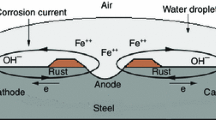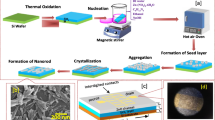Abstract
The semiconductor packaging field is evolving rapidly due to strong competition in customer demands for increased functionality and performance, further miniaturization, heightened reliability and lower costs. The lifetime reliability and sequential performance of solid-state products are mainly based on the device junction temperature (Tj). The main concerns of efficient thermal management in heat source-based electronic packages are controlling and reducing the device junction temperature and total thermal resistance (Rth). The optimization of process parameters to develop an anodic aluminium oxide nanopore (AAO-np) structure on an Al5052 alloy substrate using an electrochemical process (two-step anodization) is proposed based on the Taguchi orthogonal array (L9). The four major parameters are the electrolyte, anodization time, bath temperature, and applied voltage, which are varied at three different levels. This experiments aim to finalize suitable process parameters and their levels towards optimum Rth and Tj. The morphology of the step-wise preparation of AAO-np structure is discussed for the optimized conditions of 0.3 M oxalic acid, a 3 h anodization time, a 30 V applied voltage, and a bath at room temperature. The resulting AAO-np structure has a pore diameter of 40 to 55 nm and a height of 6 to 7 μm. This formation significantly reduces Rth by 24.58% and Tj by 24.66% for the electronic package compared to a bare Al substrate.








Similar content being viewed by others
References
A. Permal, M. Devarajan, H.L. Hung, T. Zahner, D. Lacey, K. Ibrahim, Controlled high filler loading of functionalized Al2O3-filled epoxy composites for LED thermal management. J. Mater. Eng. Perform. 27(3), 1296–1307 (2018). https://doi.org/10.1007/s11665-018-3151-y
P. Anithambigai, D. Mutharasu, L.H. Huong, T. Zahner, D. Lacey, Synthesis and thermal analysis of aluminium nitride filled epoxy composites and its effective application as thermal interface material for LED applications. J. Mater. Sci. Mater. Electron. 25(11), 4814–4821 (2014). https://doi.org/10.1007/s10854-014-2238-y
M.S. Idris, S. Subramani, W.M.W.A. Kamil, M. Devarajan, Synthesis of MgO thin film on aluminum and copper substrates as thermal interface materials. IEEE Trans. Electron Devices 66(3), 1450–1457 (2019). https://doi.org/10.1109/TED.2019.2895622
H.C. Cheng, W.H. Chen, H.F. Cheng, Theoretical and experimental characterization of heat dissipation in a board-level microelectronic component. Appl. Therm. Eng. 28(5–6), 575–588 (2008). https://doi.org/10.1016/j.applthermaleng.2007.04.013
F.P. Du et al., Enhancing the heat transfer efficiency in graphene-epoxy nanocomposites using a magnesium oxide-graphene hybrid structure. ACS Appl. Mater. Interfaces 7(26), 14397–14403 (2015). https://doi.org/10.1021/acsami.5b03196
K.E. Meyer et al., Crystalline coherence length effects on the thermal conductivity of MgO thin films. J. Mater. Sci. 51(23), 10408–10417 (2016). https://doi.org/10.1007/s10853-016-0261-5
A. Kamyar, K.S. Ong, R. Saidur, Effects of nanofluids on heat transfer characteristics of a two-phase closed thermosyphon. Int. J. Heat Mass Transf. 65, 610–618 (2013). https://doi.org/10.1016/j.ijheatmasstransfer.2013.06.046
A.A. Wereszczak et al., Thermally conductive MgO-filled Epoxy molding compounds. IEEE Trans. Compon. Packag. Manuf. Technol. 3(12), 1994–2005 (2013). https://doi.org/10.1109/TCPMT.2013.2281212
A. Ramar, D. Mutharasu, N. Puurnaraj, Growth of star gooseberry-like nickel–phosphorus films on aluminium as thermal interface material for light-emitting diode application. J. Mater. Sci. Mater. Electron. 30(15), 14156–14166 (2019). https://doi.org/10.1007/s10854-019-01783-2
N. Tsyntsaru, Porous anodized aluminium oxide: Application outlooks. Chemija 27(1), 17–23 (2016)
H.C. Weng, M.H. Yang, Heat transfer performance enhancement of gravity heat pipes by growing aao nanotubes on inner wall surface. Inventions (2018). https://doi.org/10.3390/inventions3030042
M. Sundararajan, S. Subramani, M. Devarajan, M. Jaafar, Synthesis and analysis of anodic aluminum oxide-nanopore structure on Al substrates for efficient thermal management in electronic packaging. J. Mater. Sci. Mater. Electron. (2020). https://doi.org/10.1007/s10854-020-03507-3
Y. Cui, Y. Ding, S. Xu, Y. Wang, W. Rao, J. Liu, Study on heat transfer and corrosion resistance of anodized aluminum alloy in gallium-based liquid metal. J. Electron. Packag. Trans. ASME (2019). https://doi.org/10.1115/1.4041665
M.K. Kushwaha, A comparative study of different electrolytes for obtaining thick and well-ordered nano-porous anodic aluminium oxide (AAO) films. Procedia Mater. Sci. 5, 1266–1273 (2014). https://doi.org/10.1016/j.mspro.2014.07.438
G.E.J. Poinern, N. Ali, D. Fawcett, Progress in nano-engineered anodic aluminum oxide membrane development. Materials 4(3), 487–526 (2010)
D. H. Besterfield, C. Besterfield-Michna, G.H. Besterfield, M. Besterfield-Sacre, H. Urdhwareshe, R. Urdhwarshe, Total quality management, 3rd edn. (Pearson Education India, 2011)
D.C. Montgomery, Design and analysis of experiments, 8th edn. (John Wiley & Sons Inc, Hoboken, NJ, 2012)
A.A. Dar, N. Anuradha, An application of Taguchi L9 method in black scholes model for European call option. Int. J. Entrep. 22(1), 1–13 (2018)
S. Mohapatra, G.B. Nando, Chemical modification of natural rubber in the latex stage by grafting cardanol, a waste from the cashew industry and a renewable resource. Ind. Eng. Chem. Res. 52(17), 5951–5957 (2013). https://doi.org/10.1021/ie400195v
Y. Ma, H. Hu, D. Northwood, X. Nie, Optimization of the electrolytic plasma oxidation processes for corrosion protection of magnesium alloy AM50 using the Taguchi method. J. Mater. Process. Technol. 182(1–3), 58–64 (2007). https://doi.org/10.1016/j.jmatprotec.2006.07.007
W.J. Stepniowski, D. Zasada, Z. Bojar, First step of anodization influences the final nanopore arrangement in anodized alumina. Surf. Coatings Technol. 206(6), 1416–1422 (2011). https://doi.org/10.1016/j.surfcoat.2011.09.004
C.K. Chung, C.H. Tsai, C.R. Hsu, E.H. Kuo, Y. Chen, I.C. Chung, Impurity and temperature enhanced growth behaviour of anodic aluminium oxide from AA5052 Al-Mg alloy using hybrid pulse anodization at room temperature. Corros. Sci. 125, 40–47 (2017). https://doi.org/10.1016/j.corsci.2017.05.027
S. Krishna Madhavi, D. Sreeramulu, M. Venkatesh, Evaluation of optimum turning process of process parameters using DOE and PCA Taguchi method. Mater. Today Proc. 4(2), 1937–1946 (2017). https://doi.org/10.1016/j.matpr.2017.02.039
S. Muralidharan, S. Balaji, M.P. Raja, Analyze and optimize the process parameters of electrochemical machining of Ti6Al4V using orthogonal array (OA8). Int. J. Eng. Trends Technol. 55(1), 16–20 (2018). https://doi.org/10.14445/22315381/ijett-v55p204
S. Kamaruddin, Z.A. Khan, K.S. Wan, The use of the taguchi method in determining the optimum plastic injection moulding parameters for the production of a consumer product. J. Mek. 18, 98–110 (2004)
W. Lee, R. Ji, U. Gösele, K. Nielsch, Fast fabrication of long-range ordered porous alumina membranes by hard anodization. Nat. Mater. 5(9), 741–747 (2006). https://doi.org/10.1038/nmat1717
M.H. Rahimi, S. Saramad, S.H. Tabaian, S.P. Marashi, A. Zolfaghari, M. Mohammadalinezhad, Study the effect of striping in two-step anodizing process on pore arrangement of nano-porous alumina. Appl. Surf. Sci. 256(1), 12–16 (2009). https://doi.org/10.1016/j.apsusc.2009.04.155
Acknowledgements
The authors would like to thank WDC–USM (MIDA grant) for financial assistance. In addition, the authors would like to acknowledge TMRL Laboratory–School of Physics (USM), SERC (USM) and Western Digital Corporation for providing the characterization facilities. Finally, the authors thank School of Materials and Mineral Resources Engineering for providing lab facilities.
Author information
Authors and Affiliations
Corresponding author
Additional information
Publisher's Note
Springer Nature remains neutral with regard to jurisdictional claims in published maps and institutional affiliations.
Rights and permissions
About this article
Cite this article
Sundararajan, M., Subramani, S., Devarajan, M. et al. Optimization of process parameters of anodic aluminium oxide using an orthogonal array technique for thermal management applications. J Mater Sci: Mater Electron 31, 18706–18720 (2020). https://doi.org/10.1007/s10854-020-04412-5
Received:
Accepted:
Published:
Issue Date:
DOI: https://doi.org/10.1007/s10854-020-04412-5




